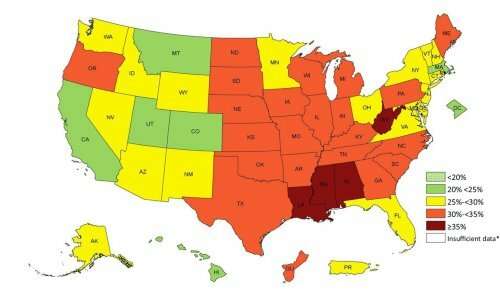Monitoring obesity risk from space

In public health research, like obesity studies, spatial technologies can add very valuable information. Combining remote sensing, geo-information systems and GPS will enable us to identify typical obesogenic environments. Until now, only part of this type of information is used, while the combination – also called 3S technology—has a large potential, according to researcher Peng Jia of the University of Twente (ITC). He publishes about current applications and future promise of 3S technologies in his paper in Trends in Endocrinology and Metabolism.
Obesity is a growing health problem. Governments have developed lifestyle improvement programmes. But what about the influence that the daily environment has on obesity risk? Does it accommodate exercise or going to work by bike? How about the availability of healthy food versus unhealthy food? And where do climate and temperature fit in?
Obesity research is often done using questionnaires combined with activity tracking, sometimes adding aspects like income position and the social environment. But there is a lot more of information available from satellite images and geo-information systems, enabling researchers to identify regions with more or less obesity risk, according to Peng Jia. He is a researcher at the UT's ITC Faculty of Geo-Information Science and Earth Observation, and he is the director of a global research network International Initiative on Spatial Lifecourse Epidemiology.
Remote sensing via satellite provides many details about natural and built environments, including climate data. Geo-information systems add a lot of details, like the location of shops, restaurants, parks and sports facilities. Is healthy food within reach, or is it tempting to go for a fast-food chain? What about the affordability? This may give rise to complicated questions: in the US, for example, a big supermarket offering a great choice of food, including healthy food, is often situated on a location that is typically made for going by car, with the fast-food chains present very nearby. This environment has obesogenic aspects, but also ingredients for a more healthy lifestyle. Adding data coming from individuals, using GPS tracking for example, enables researchers to zoom in and find out which effects are predominant here.
Using detailed knowledge of environment-related risk of obesity, interventions will be possible, as well. Even on a city level, neighbourhoods can be compared to see what works in obesity prevention. Spatial technologies have become increasingly accessible and affordable, according to Peng Jia, so it can be of great added value to health research. UT's ITC faculty has a lot of experience in collecting and interpreting these spatial data. The approach Peng Jia describes in his paper, is not limited to obesity: for many other diseases, information on the environment uniquely captured by 3S technologies will add a lot of value as well.
More information: Peng Jia et al. Spatial Technologies in Obesity Research: Current Applications and Future Promise, Trends in Endocrinology & Metabolism (2019). DOI: 10.1016/j.tem.2018.12.003


















